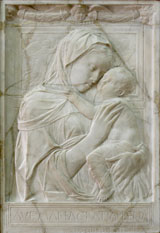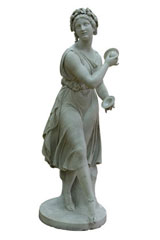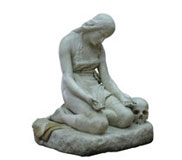Collection / European
Sculpture
 In the mid fifteenth century secular tendencies spread widely in both Florentine painting and sculpture,also embracing also religious subjects. The best example of this is the high relief “Adoration of the Shepherds”, made in the technique of majolica, by an unknown master in Luca della Robbia’s studio.
In the mid fifteenth century secular tendencies spread widely in both Florentine painting and sculpture,also embracing also religious subjects. The best example of this is the high relief “Adoration of the Shepherds”, made in the technique of majolica, by an unknown master in Luca della Robbia’s studio.
The period of Italian High Renaissance is represented by the bronze copy of “Madonna with Child” by one of greatest masters, Michelangelo Buonarroti (1475-1564). This sculpture gives an idea of the master’s authentic and convincing art. 
A long period of time separates the above-mentioned Italian works from the other exhibits. In the first half of the nineteenth century Italy was the center of classical art. In order to study the heritage of the past, artists from other countries came to Italy to improve their skill with the help of Italian teachers. In the first two decades of the century Antonio Canova (1757-1822) was one of the most famous sculptors of Europe.In his work the Baroque traditions of the previous century were gradually replaced by the principles of Classicism. With its harmonious composition and masterly treatment of the material his marble sculpture “The Repenting Mary Magdalene” representing the well-known Evangelic subject is quite characteristic of the author’s work. The traditions of classicism with monumental dispositions continued existing in the marble works of the sculptors of the second half of the nineteenth century, namely Luigi Bienaime (1975-1878), Vincenzo Luccardi (1808-1876), and Giovanni Dupre (1817-1882).
Among the works of other European countries the small wooden sculpture “Pieta” by an unknown Flemish master of the seventeenth century is worth mentioning; its dramatic content is embodied in expressive, anxious sculptural forms.
 The Danish sculptor Albert Bertel Thorvaldsen (1770-1844) graduated from the Copenhagen Academy and left for Rome, where he became as famous as Canova. His portrait of Alexander I displays profound insight and restraint in the means of expression.
The Danish sculptor Albert Bertel Thorvaldsen (1770-1844) graduated from the Copenhagen Academy and left for Rome, where he became as famous as Canova. His portrait of Alexander I displays profound insight and restraint in the means of expression.
The allegorical statue of the German sculptor of the second half of the nineteenth century Albert Wolf (1814-1892), “Time”, was also created according to the principles of the classicism. The skilful mastering of the form and the perfect composition allow us to rank this work among noteworthy sculptures of its time.
French sculpture is best represented in the Gallery by outstanding names from the second half of the seventeenth to the beginning of the twentieth century.
Francois Girardon (1628-1715) participated for many years in the construction of the Versailles complex, the main residence of Louis XIV. Among other sculptures created was the marble group “The Abduction of Persephone”. Its small bronze variant is kept in the Gallery. This sculptural group with outward patheric features is a very characteristic example of Classicism.
In the eighteenth century mythological and allegorical subject-matters were widespread in French sculpture. Artistic solutions became refined, and elegant in form, which endowed the works with an intimate atmosphere.
Guillaume Coustou (1677-1746) is one of the distinguished masters of the first half of the century.Among his famous works are the two decoratively interpreted marble groups of men bridling horses,which he made for the palace in Marly (later they were transferred to the Concorde Square in Paris). Their models cast in bronze are included in the exhibition.
Another brilliant artist of the eighteenth century exhibited in the Gallery is Etienne Maurice Falconet (1716-1791). One of his famous works, also well-known in his motherland is the variant of “Amour”, which is displayed in the gallery. The mythological personage is interpreted as a playful boy whose figure is shaped in smooth, fluent contours, with softly modeled forms. For twelve years Falconet lived in Russia and created the monument to Peter I, the famous “Copper Rider”.
Falconet’s contemporary Jean Jacques Caffieri (1725-1792) is represented in the collection by the terracotta “Bust of a Woman”. Having preserved the peculiarities of the material with high technical skill and good sense of form, the artist has created a surprisingly vivid image of the lovely model.
Claude Michel (1738-1814), nicknamed Clodion, sculpted small scale works. His favourite personages were mythological Nymphs and Bacchantes, and his favourite material was clay. Clodion’s scenes of everyday life, as well as the “Satyr and Nymph” exhibited in the Gallery are characterized by impulsivness and elegance.
This brilliant pleied of French artists is completed by the greatest master of realistic sculpture Jean Antoine Heudon (1741-1828), who had considerable achievements in the genre of portraiture. Among his monumental and decorative works is the marble statue of Diana. The bronze casting of its small model is kept in the collection of the Museum. The nude figure with a magnificent silhouette is full of vivacity and is absolutely deprived of academic severity.
At the end of the nineteenth century French art was a complex medley of various styles. In the period of modern history appeared the outstanding individuality of the great master of sculpture August Rodin (1847-1910). His work significantly influenced the futher development of world sculpture. In the collection of the Gallery, he is represented by the bronze portrait “Suzon”, a variant of which is kept in Rodin’s museum in Paris.